“The future of agriculture lies in the hands of technology,” said Norman Borlaug, the father of the Green Revolution. Today, his words resonate more than ever as autonomous systems are reshaping the way we grow food. From self-driving tractors to drone surveillance, these innovations are driving efficiency and sustainability in modern farming.
Digital assistants are now optimizing complex tasks, reducing water usage by 20-50%, and improving crop health through real-time monitoring1. Predictive analytics are enhancing supply chains, cutting food waste by 25%, and ensuring resources are used wisely2. These advancements are not just improving productivity but also addressing global challenges like climate change and food security3.
As we move from manual labor to data-driven precision, the integration of these technologies is becoming essential for farmers worldwide. This article explores how these systems are revolutionizing the field and why they are critical for the future of sustainable agriculture.
Key Takeaways
- Autonomous systems are transforming agriculture by automating tasks and improving efficiency.
- Digital assistants optimize resource use, reducing water and fertilizer consumption.
- Predictive analytics enhance supply chains, minimizing food waste.
- Self-driving machinery increases productivity and reduces labor costs.
- These technologies are essential for addressing global challenges like climate change.
Introduction to Modern AgTech Innovations
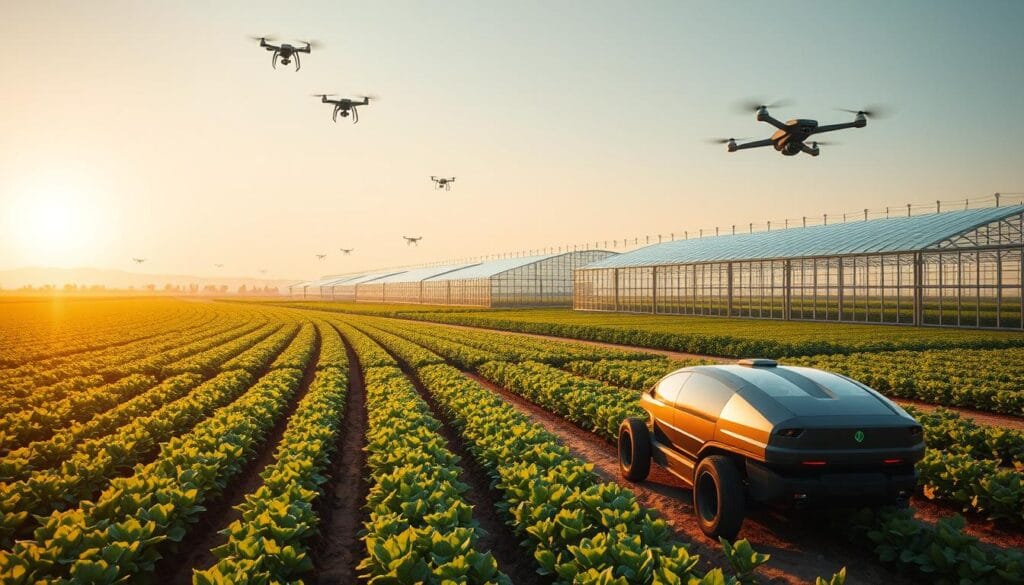
Innovative tools like GPS-guided tractors and sensor networks are transforming traditional farming methods. These advancements are helping farmers monitor crops and soil conditions with unmatched precision, ensuring healthier plants and higher yield.
The integration of IoT devices and data analytics is revolutionizing agricultural practices. Farmers can now access real-time insights into weather patterns, moisture levels, and nutrient needs. This data-driven approach allows for tailored interventions, such as precision irrigation and fertilization, maximizing resource efficiency4.
For example, smart irrigation systems adjust watering levels based on soil moisture sensors and weather forecasts. This reduces water waste and improves crop quality5. Similarly, precision scheduling ensures that resources like fertilizers are applied at the right time and in the right amounts, boosting yield while minimizing environmental impact.
These technology breakthroughs are not just about efficiency; they are essential for addressing global challenges like food security and climate change. By adopting these innovations, farmers can achieve sustainable and resilient farming practices, paving the way for a brighter future in agriculture.
Historical Evolution of Farming and Technology

From ancient plows to modern machinery, agriculture has seen a remarkable transformation. Early farmers relied on manual labor and basic tools to cultivate the land. The invention of the plow marked a significant leap, enabling more efficient soil preparation and crop cultivation6.
The Green Revolution in the mid-20th century introduced high-yield crops and chemical fertilizers, boosting global food production. This era laid the foundation for modern management practices, emphasizing resource efficiency and productivity7.
Today, precision farming techniques have revolutionized the industry. Advanced systems use data analytics and IoT devices to monitor soil health and optimize resource use. These innovations build on historical methods, ensuring sustainable and efficient farming practices8.
The shift from traditional to digital farming highlights the need for advanced technologies. By learning from the past, farmers can adopt smarter systems to address modern challenges like climate change and food security.
AI Agents in Agriculture: Optimizing Farming Practices
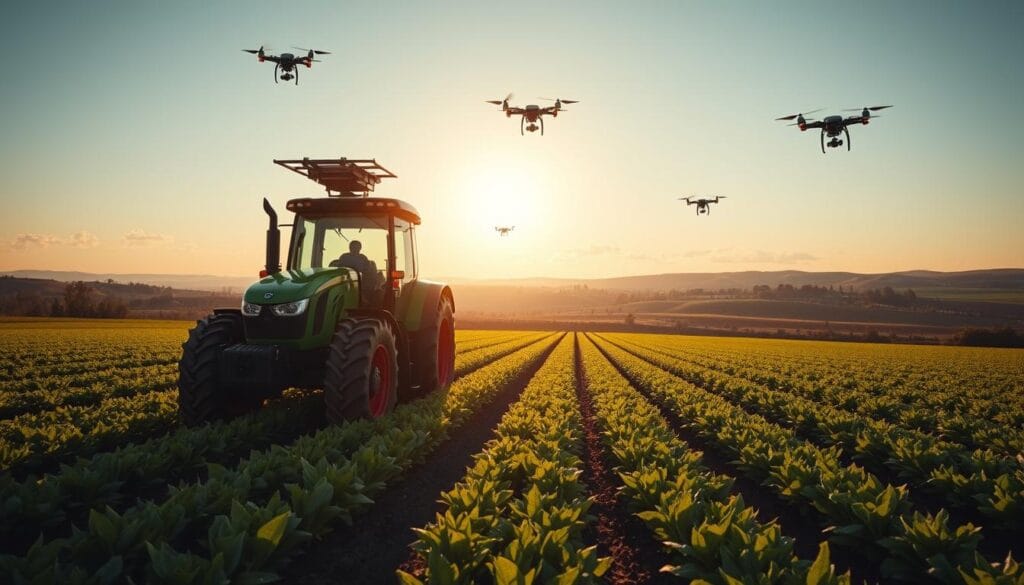
Real-time data analysis is now a cornerstone of modern agricultural practices. Advanced systems analyze vast amounts of datum to make informed decisions about irrigation, planting, and harvesting. This approach ensures resources are used efficiently, reducing waste and improving outcomes9.
These tools achieve precision by monitoring soil moisture, weather patterns, and crop health. For example, connected systems can automate irrigation, ensuring water is applied only when necessary9. This not only conserves resources but also enhances crop quality.
Machine learning applications further refine these processes. They detect early signs of pest infestations, enabling timely interventions to minimize damage10. Farmers receive real-time alerts for extreme weather events, significantly reducing crop loss risks9.
The role of artificial intelligence in agriculture is transformative. It empowers farmers to make data-driven decisions, increasing profitability and sustainability. By adopting these technologies, the industry is moving toward a more efficient and resilient future.
Implementing Precision Farming through AI Technologies
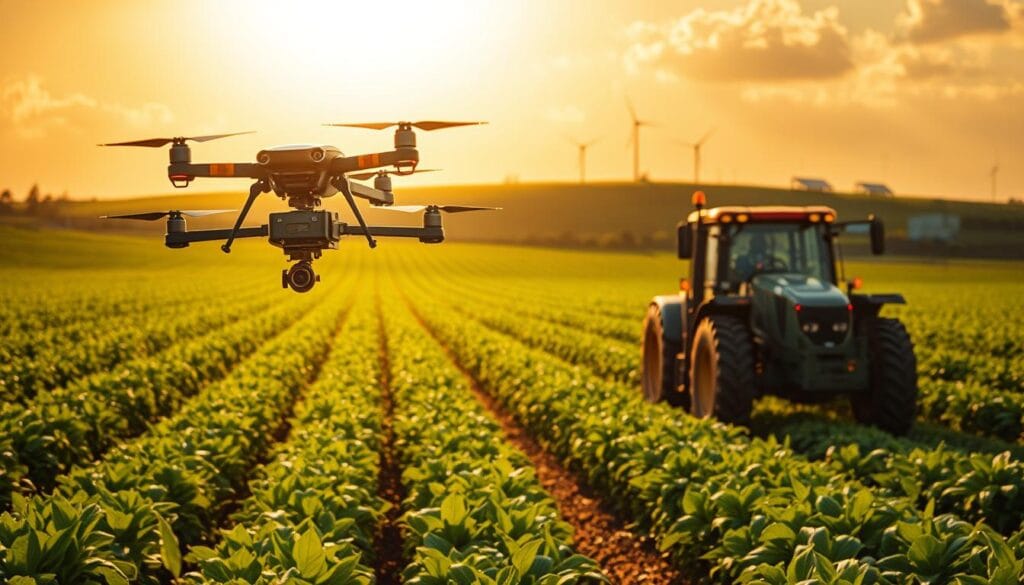
Precision farming is revolutionizing how resources are managed on farms, ensuring efficiency and sustainability. By leveraging advanced technologies, farmers can fine-tune agricultural inputs like water, fertilizers, and pesticides. This approach minimizes waste and maximizes crop yields11.
Machine learning models play a crucial role in optimizing planting schedules and irrigation strategies. These models analyze data from sensors and weather forecasts to make precise recommendations. For example, smart irrigation systems adjust water usage based on real-time soil moisture levels, reducing consumption by 30-50%12.
Technological applications, such as sensors and automated systems, are reducing manual labor on farms. Robotic harvesters, for instance, can cut labor costs by up to 50% while increasing harvesting speed by 30%12. These innovations not only save time but also improve operational efficiency.
However, adopting these technologies comes with challenges. Many farms lack the necessary infrastructure, and the financial feasibility of implementation is a concern. High costs associated with advanced systems can be a barrier for smaller operations11. Additionally, data availability and quality are critical for effective model training, which can be a hurdle in conventional farming environments13.
Despite these challenges, the long-term benefits of precision farming are undeniable. By integrating these technologies, farmers can achieve higher profitability and sustainability. This foundation sets the stage for further advancements in agentic automation on farms.
Optimizing Planting, Irrigation, and Harvesting Strategies
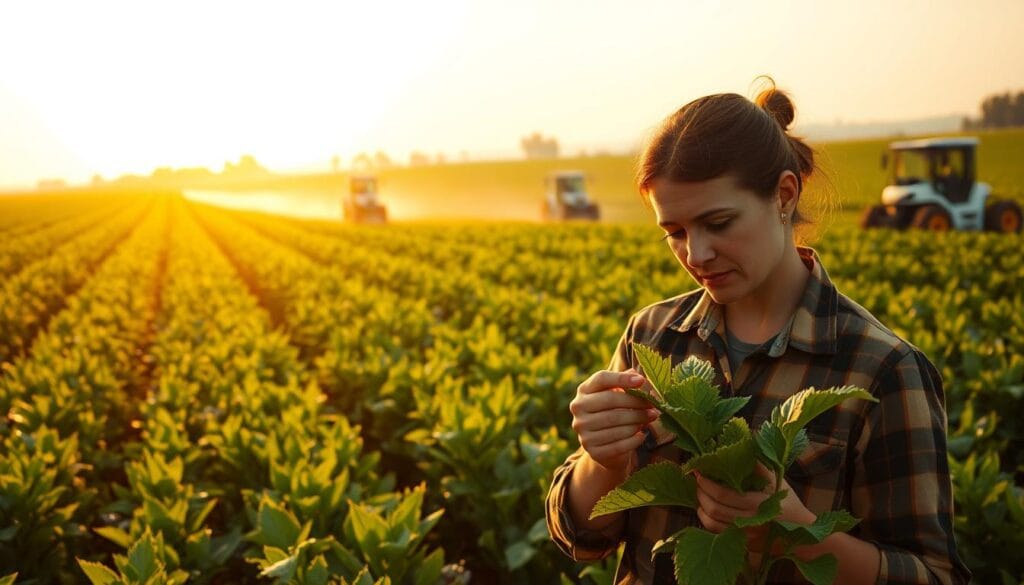
Advanced technologies are reshaping how farmers approach planting, irrigation, and harvesting. These innovations are not just improving efficiency but also ensuring sustainable farming practices. By leveraging data-driven methods, farmers can make smarter decisions that enhance productivity and reduce waste.
Machine Learning in Crop Scheduling
Machine learning models are revolutionizing crop scheduling by analyzing data to determine the best planting times and rotation strategies. These models consider factors like soil condition, weather forecasts, and crop health to optimize schedules14. For example, predictive analytics can forecast the ideal planting window, ensuring higher yields and reduced risks11.
Case studies show that farms using these systems have seen a 15% increase in productivity15. However, integrating these technologies requires adapting traditional practices, which can be challenging for some farmers.
Smart Irrigation Systems
Smart irrigation systems are transforming water management by adjusting water supply based on real-time data. These systems monitor soil moisture and weather conditions, ensuring crops receive the right amount of water14. This approach reduces water waste by up to 50%, making it a sustainable solution for modern farming11.
For instance, automated systems can detect dry patches and deliver water precisely where needed15. Despite their benefits, the high costs of implementation remain a barrier for smaller operations.
Adopting these advanced strategies requires a shift in mindset and practice. While the initial investment may be high, the long-term benefits in efficiency and sustainability make it a worthwhile endeavor. As technology continues to evolve, the future of farming looks brighter than ever.
Enhancing Crop Yield with Data-Driven Insights
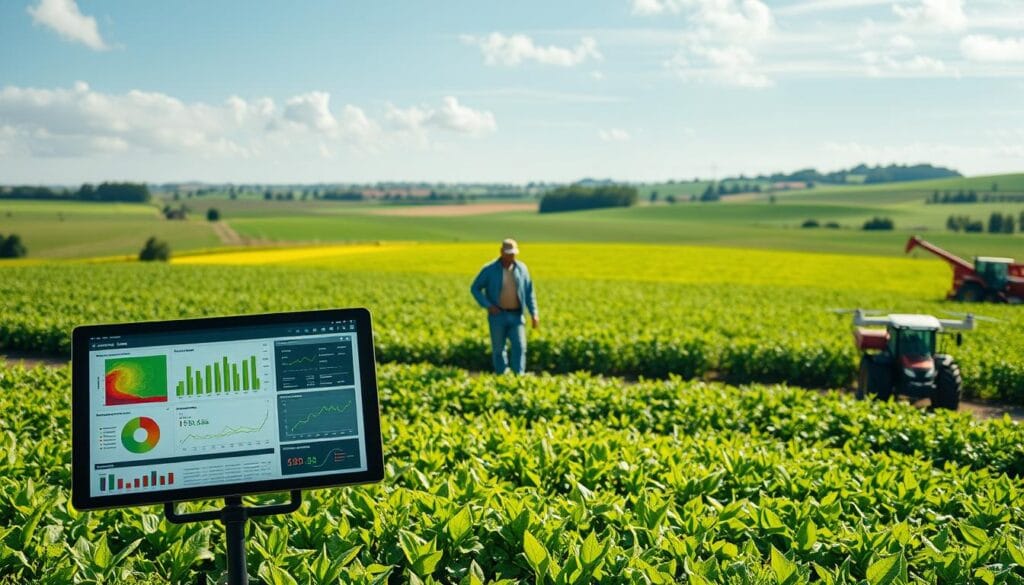
Harnessing the power of data is transforming how farmers approach crop management. By leveraging advanced analytics, they can make informed decisions that boost productivity and sustainability. This section explores how predictive analytics and integrated technologies are revolutionizing yield optimization.
Predictive Analytics for Yield Forecasting
Predictive analytics combines weather data, historical trends, and satellite imagery to forecast crop yields accurately. These tools analyze patterns to predict growth and detect potential risks, enabling farmers to plan effectively16. For example, systems can anticipate pest outbreaks, reducing crop losses by up to 30%17.
Farmers using these methods report higher yields and improved profitability. By optimizing planting schedules and resource allocation, they achieve better results with fewer inputs16. This approach not only enhances efficiency but also minimizes environmental impact.
Integration of Sensor Data and Satellite Imagery
Sensor networks and satellite imagery provide real-time insights into soil moisture, nutrient levels, and crop health. These technologies enable precise irrigation and fertilization, reducing waste and improving outcomes16. For instance, drones capture high-resolution images, offering detailed field visibility for better decision-making17.
Combining these data sources allows farmers to monitor conditions closely and respond quickly. This integration leads to significant water conservation and healthier crops, ensuring sustainable practices16. The result is a more resilient and productive farming system.
Data-driven insights are reshaping modern agriculture. By adopting these technologies, farmers can optimize resources, reduce risks, and achieve higher yields. The future of crop management lies in the seamless integration of data and technology.
Intelligent Soil Health Monitoring and Management
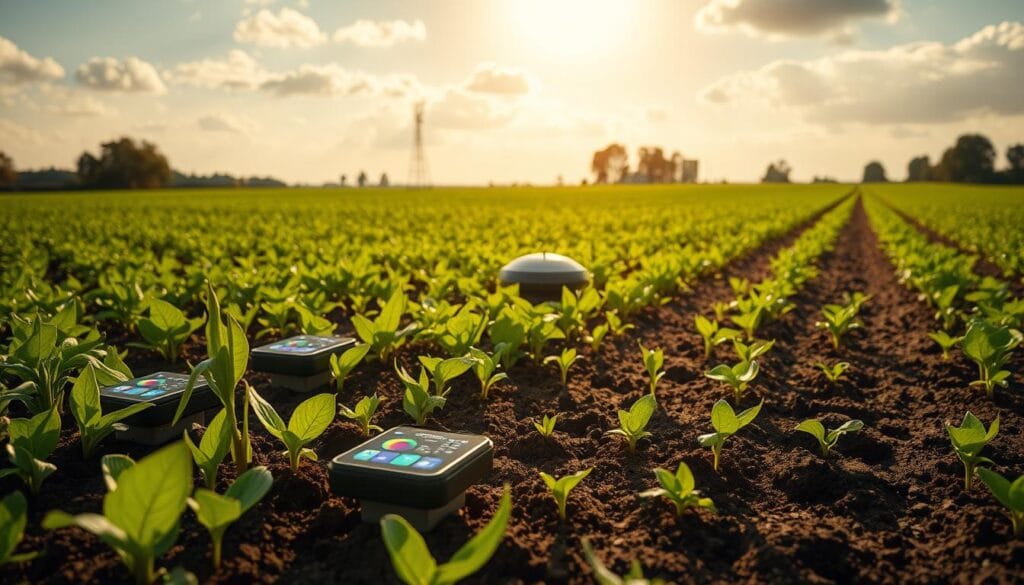
The future of sustainable farming lies in intelligent soil health monitoring. Emerging tools like IoT sensors and analytical models are transforming how farmers assess and manage soil conditions. These technologies provide real-time insights into nutrient levels and soil composition, enabling precise interventions18.
Intelligent systems analyze data from sensors to assess soil health dynamically. For example, they can detect nutrient deficiencies and recommend tailored fertilization strategies19. This approach not only improves crop yields but also reduces environmental impact by minimizing overuse of fertilizers.
Improved soil management contributes significantly to sustainable practices. By optimizing nutrient application, farmers can enhance soil fertility and ensure long-term productivity20. This is particularly important as the global demand for food continues to rise.
Concrete examples of these technologies include automated systems that control fertilization processes. For instance, John Deere’s See & Spray technology reduces chemical usage by up to 90%, ensuring efficient resource use18. Similarly, CropX’s technology saves up to 40% on water usage while increasing yields by 10–20%18.
The future potential of these tools is immense. As technology evolves, they will play a crucial role in addressing challenges like climate change and food security. By adopting intelligent soil health monitoring, farmers can achieve sustainable and resilient farming practices.
For more insights into how technology is transforming industries, explore AI-driven diagnostics and their applications in modern agriculture.
Early Disease and Pest Detection Using AI Tools

Cutting-edge technology is revolutionizing how farmers detect and manage crop diseases and pests. Advanced tools now provide timely insight into potential threats, enabling proactive measures to protect yields21.
Image recognition and deep learning models play a critical role in identifying early signs of crop stress. These systems analyze patterns in plant health, detecting diseases and pests with up to 95% accuracy21. For example, aphid infestations can be identified early, reducing crop loss by 30%21.
By leveraging these tools, farmers can minimize risk and reduce pesticide usage by 20-30%21. Targeted interventions ensure resources are used efficiently, safeguarding both crops and the environment.
Case studies highlight successful implementations across the supply chain. For instance, IoT applications have increased farm productivity by 15%21. These advancements not only improve yields but also enhance sustainability.
Timely insight is crucial for proactive pest control and disease prevention. With these technologies, farmers can address threats before they escalate, ensuring healthier crops and a more resilient supply chain22.
Overcoming Challenges in AI Integration on Farms
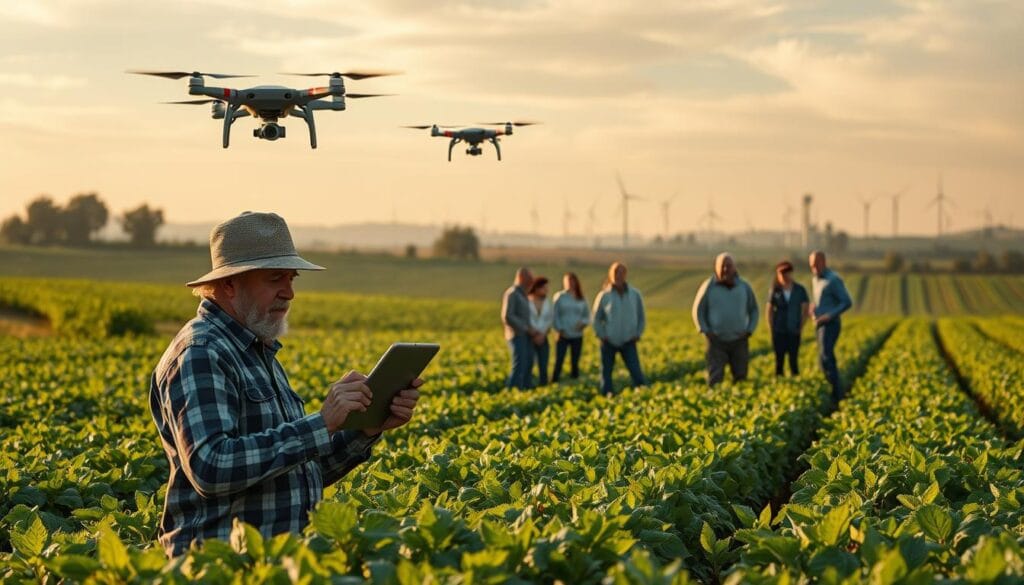
Integrating advanced technologies into traditional farming systems presents both opportunities and challenges. While these innovations promise greater efficiency and sustainability, their adoption is not without hurdles. Farmers often face technical complexities, connectivity issues, and concerns about data privacy. Addressing these challenges is crucial to ensuring the successful implementation of these systems.
Technical Complexities and Connectivity Issues
One of the primary challenges is the technical complexity of integrating these systems into existing setups. Many farms lack the infrastructure needed to support advanced tools, making implementation difficult23. Additionally, rural areas often struggle with poor internet connectivity, which limits the effectiveness of real-time monitoring and data analysis24.
Solutions like investing in better infrastructure and leveraging satellite-based connectivity can help bridge this gap. For example, IoT devices that operate offline and sync data when connectivity is available are becoming increasingly popular23. These adaptations ensure that even remote farms can benefit from advanced technologies.
Data Privacy and Security
Another significant concern is data privacy. Farmers are often hesitant to adopt digital platforms due to fears of data misuse or breaches24. Ensuring robust security measures and transparent data policies is essential to building trust. For instance, encrypted data storage and clear user agreements can reassure farmers about the safety of their information23.
By addressing these concerns, technology providers can foster greater adoption while maintaining the integrity of the food supply chain. This balance is critical for achieving long-term sustainability goals.
Overcoming these challenges requires a collaborative approach. Governments, technology providers, and farmers must work together to create solutions that are both practical and effective. By doing so, they can ensure that advanced technologies enhance quality and efficiency without compromising traditional farming values.
Strategies for Agentic Automation in Farm Operations
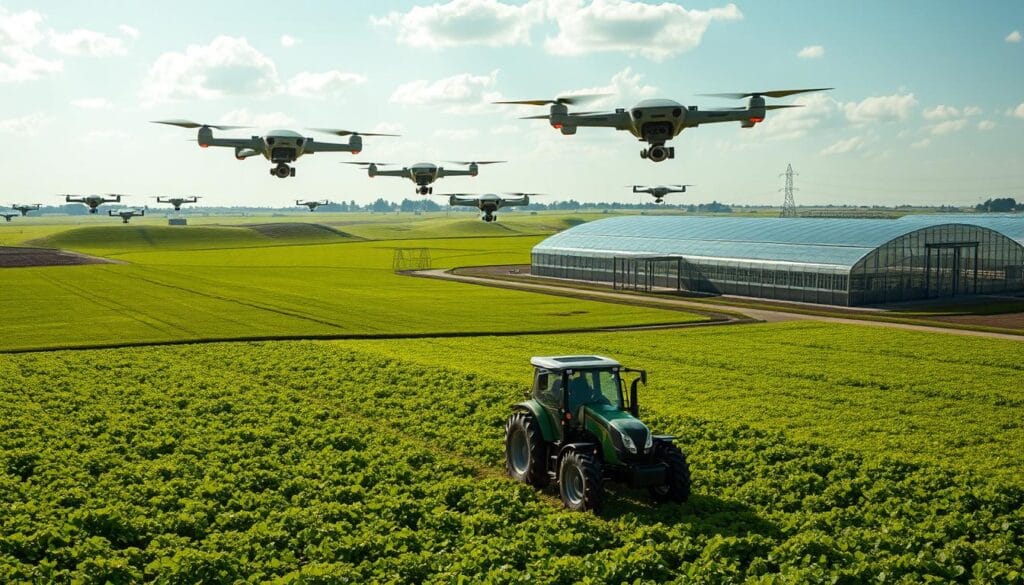
Modern farms are embracing automation to streamline operations and boost efficiency. By integrating advanced systems, they are transforming how daily tasks are managed. These technologies create a seamless chain of automated processes, from planting to harvesting25.
One key strategy is the use of collaborative platforms. These platforms merge sensor data, predictive models, and robotic operations into a unified system. For example, farms using such platforms have reported a 30% increase in productivity25. This integration ensures that every part of the supply and process chain functions effectively.
Another approach is automating repetitive tasks. Robotic systems can handle activities like planting, weeding, and harvesting with precision. This reduces labor costs and minimizes errors, enhancing overall process efficiency26.
Successful examples include farms that have adopted autonomous irrigation systems. These systems adjust water delivery based on real-time soil moisture data, reducing water usage by up to 50%25. Such innovations highlight the importance of well-designed integration in the supply chain.
By leveraging these strategies, farms can achieve greater efficiency and sustainability. For more insights on how advanced technologies are transforming operations, explore Edge AI in agriculture.
Leveraging AI for Sustainable and Resilient Farming Practices
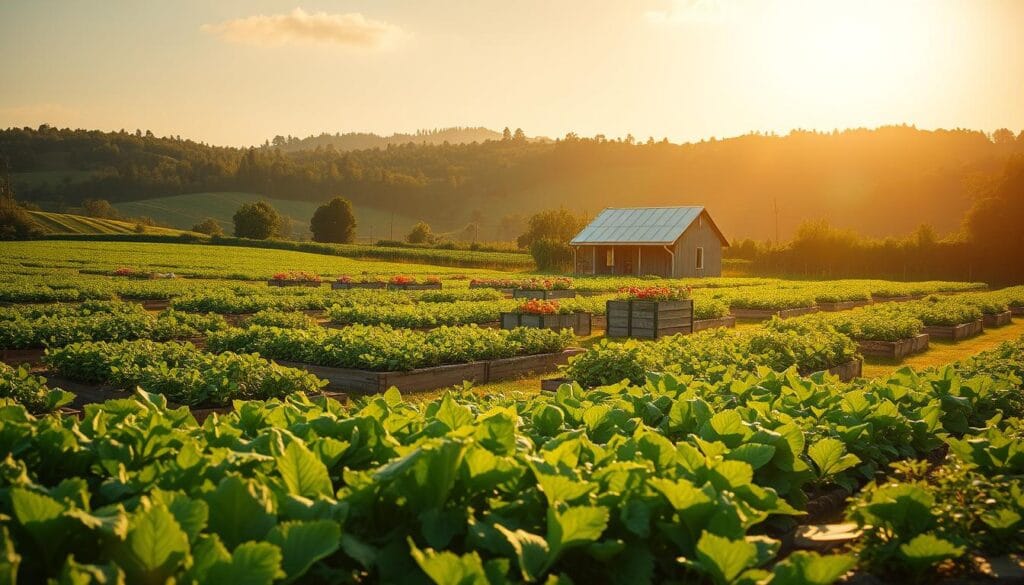
Emerging technologies are reshaping how farmers tackle environmental challenges and ensure long-term productivity. These tools help adapt to changing climate conditions, making farming more resilient and sustainable27.
One key aspect is the integration of data from multiple sources. By combining weather forecasts, soil sensors, and satellite imagery, farmers can make informed decisions. This approach improves tasks like water management and crop rotation, reducing waste and enhancing efficiency28.
For example, precision irrigation systems adjust water usage based on real-time data, conserving resources while maintaining crop health. Similarly, predictive models help optimize planting schedules, ensuring higher yields even in unpredictable climate conditions27.
These technologies also reduce environmental impact. By minimizing the use of fertilizers and pesticides, they promote healthier ecosystems. This not only benefits the environment but also ensures economic sustainability for farmers28.
Long-term benefits are significant. Resilient practices lead to consistent productivity, even in the face of global challenges like population growth. As the world population is projected to reach 9.7 billion by 2050, these innovations are essential for meeting future food demands27.
To learn more about how these systems are transforming the industry, explore sustainable farming practices.
The Role of IoT, Drones, and Robotics in Modern Agriculture
Smart technologies are revolutionizing field surveillance and crop management in modern farming. The integration of IoT devices and drones is transforming how farmers monitor their fields, ensuring precision and efficiency. These tools provide real-time insights, enabling better decision-making and reducing operational costs29.
Advanced Drone Surveillance and Crop Monitoring
Drones are playing a pivotal role in modern farming. Equipped with GPS and image processing, they identify areas of stress, pest activities, and nutrient deficiencies with unmatched accuracy29. This capability allows farmers to address issues promptly, reducing crop loss and improving yields. For example, drones can predict crop yields and diagnose pest problems, leading to a 15-20% increase in productivity30.
These devices also support precision fertigation, ensuring that resources like water and fertilizers are applied efficiently. By minimizing waste, drones contribute to sustainable practices and cost savings29.
Robotic Harvesters and Automated Systems
Robotic harvesters are another game-changer in modern farming. These systems execute precise and efficient crop collection tasks, reducing labor costs by up to 30%30. Their capability to operate autonomously ensures consistent quality and minimizes errors during harvesting.
Case studies highlight the success of these technologies. Farms using robotic systems report higher harvest quality and reduced operational expenses29. For instance, automated systems can adjust water delivery based on real-time soil moisture data, conserving resources while maintaining crop health30.
By combining IoT, drones, and robotics, farmers can achieve greater efficiency and sustainability. These smart technologies are not just modernizing farming practices but also addressing global challenges like food security and resource management29.
Future Trends and Prospects for AI in Agriculture
The future of farming is being reshaped by cutting-edge technologies that promise greater efficiency and sustainability. Emerging tools are set to transform how farmers manage crops, optimize resources, and address global challenges like climate change and food security31.
One of the most significant advancements is in soil health monitoring. IoT sensors and analytical models now provide real-time insights into nutrient levels and soil composition. These tools enable precise interventions, ensuring healthier crops and higher yields32.
Machine learning models are also scaling up, offering predictive analytics for crop yield and pest detection. These systems analyze vast datasets to forecast growth patterns and identify risks early. Farmers can make informed decisions, reducing losses and improving profitability31.
The integration of these technologies is driving the use of autonomous systems like drones and robotic harvesters. These tools enhance operational efficiency, reduce labor costs, and minimize environmental impact. For example, drones can monitor fields with high precision, while robotic systems ensure consistent crop quality32.
Industry projections indicate significant growth in this sector. The market for advanced agricultural tools is expected to expand as more farmers adopt these innovations. This growth reflects the increasing reliance on data-driven solutions to meet future food demands31.
As these technologies evolve, they will play a crucial role in creating sustainable and resilient farming practices. By addressing longstanding challenges, they pave the way for a brighter future in agriculture.
Conclusion
The integration of advanced tools is reshaping how farmers approach resource management and productivity. These technologies, such as predictive analytics and smart irrigation, are optimizing resource use and improving yields. For instance, smart systems can reduce water usage by up to 30% while maintaining crop health33.
Autonomous machines are also enhancing efficiency, reducing labor costs by up to 50%33. These innovations address critical challenges like data security and technical complexities, ensuring sustainable practices. Farmers can now make data-driven decisions, increasing profitability and resilience.
Looking ahead, these tools will play a pivotal role in meeting global food demands. By adopting these technologies, the industry is moving toward a more efficient and sustainable future. The transformative impact of these advancements promises a brighter tomorrow for farmers and consumers alike.
FAQ
How does machine learning improve crop scheduling?
What are the benefits of smart irrigation systems?
How does predictive analytics help in yield forecasting?
What role do drones play in modern agriculture?
How does AI assist in soil health monitoring?
What challenges arise with AI integration on farms?
How can robotics improve farm operations?
What is the future of AI in agriculture?
Source Links
- No title found
- Transforming Agriculture: The Rise of AI in Commercial Farming | AgriTechTomorrow
- Benefits of AI in Agriculture: Maximizing Yields with Precision Farming I Novus
- Paper Title (use style: paper title)
- 7 Applications of AI in Agriculture | 2024 Updated | BasicAI’s Blog
- SmythOS – Autonomous Agents in Agriculture
- Historical Timeline Of AI In Precision Agriculture | Restackio
- Innovative Agriculture Technologies Transforming the Industry | ICL
- 100 Days of Agentic AI Day 74: AI Agents for Sustainable Agriculture
- AI for Agricultural Operations
- AI in Agriculture: Benefits and Use Cases – Moon Technolabs
- AI in Agriculture: Optimizing Food Production and Sustainability
- Revolutionizing Agriculture: Precision Scouting and AI-Driven Insights for Optimized Crop Performance and Farm Profitability –
- Role of AI in Agriculture: Use Cases, Benefits, and Challenges
- Reinforcement Learning Applications In Agriculture | Restackio
- AI in Precision Agriculture: Optimizing Crop Yield Through Data-Driven Insights – The Data Scientist
- Data-Driven Farming: How AI and Machine Learning Enhance Crop Yield – Agrowise Farm
- AI and Agriculture: Revolutionizing Farming with Artificial Intelligence
- Harnessing AI Agents for a Greener Future: The Transformation of Precision Agriculture
- How Farmers and AI Can Work Together for Success | Keymakr
- Transforming Pest Management with Artificial Intelligence Technologies: The Future of Crop Protection – Journal of Crop Health
- Early Crop Disease Detection with AI: Strategies for Prevention
- AI in Agriculture: Transforming Farming with Technology
- Who is responsible for ‘responsible AI’?: Navigating challenges to build trust in AI agriculture and food system technology – Precision Agriculture
- AI Revolutionizing Agriculture: Enhancing Efficiency and Sustainability
- Utilizing Analytics for Agricultural Decision Making: Crop Planning and Risk Management
- The Next Frontier: Leveraging AI and Agriculture
- How IoT in Agriculture is Transforming the Farming Landscape
- Artificial intelligence on the agro-industry in the United States of America
- Harnessing AI Agents in Agriculture: The Dawn of Agentic Automation in AgTech
- AI in Current and Future Agriculture: An Introductory Overview – KI – Künstliche Intelligenz
- How Farmers Can Utilize AI to Increase Crop Yield







